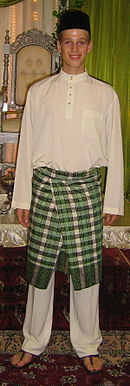Baju Melayu
Baju Melayu is a traditional, two-piece Malay clothing made of cotton , nowadays often made of a cotton- polyester blend.
Translated, the name means Malay shirt . Except on solemn occasions, such as the festival of the breaking of the fast (Hari Raya Aidilfitri) , Malay men wear it mainly for religious events and also when praying . In Malaysia there are some Baju models that differ from the normal pattern , such as the Johor design.
The Johor design is called Teluk Belanga , while the original design is called Cekak Musang .
Appearance
The long- sleeved shirt is usually equipped with three pockets (one breast pocket) and a 1 to 2 cm high stand-up collar . You button it with five non-integrated buttons . The simple, long trousers have no trouser pockets and are buttoned tighter on the sides according to the hip circumference.
In the Malaysian state of Johor , the collar is similar to the female counterpart of the Baju Melayus, the Baju Kurung . The top halves of the shirt are held together in a loop with just a single button. The round collar rests on the wearer's shoulders .
Ways of carrying
Usually you stuff the shirt into the pants and wear a skirt-like fabric ( samping or the simpler sarong ) over the shirt at waist height . For wedding occasions also the headgear are songkok and wedding shoes Capal usual. If all of the clothes mentioned match each other in terms of color and material, the Malay costume is called sedondon .
